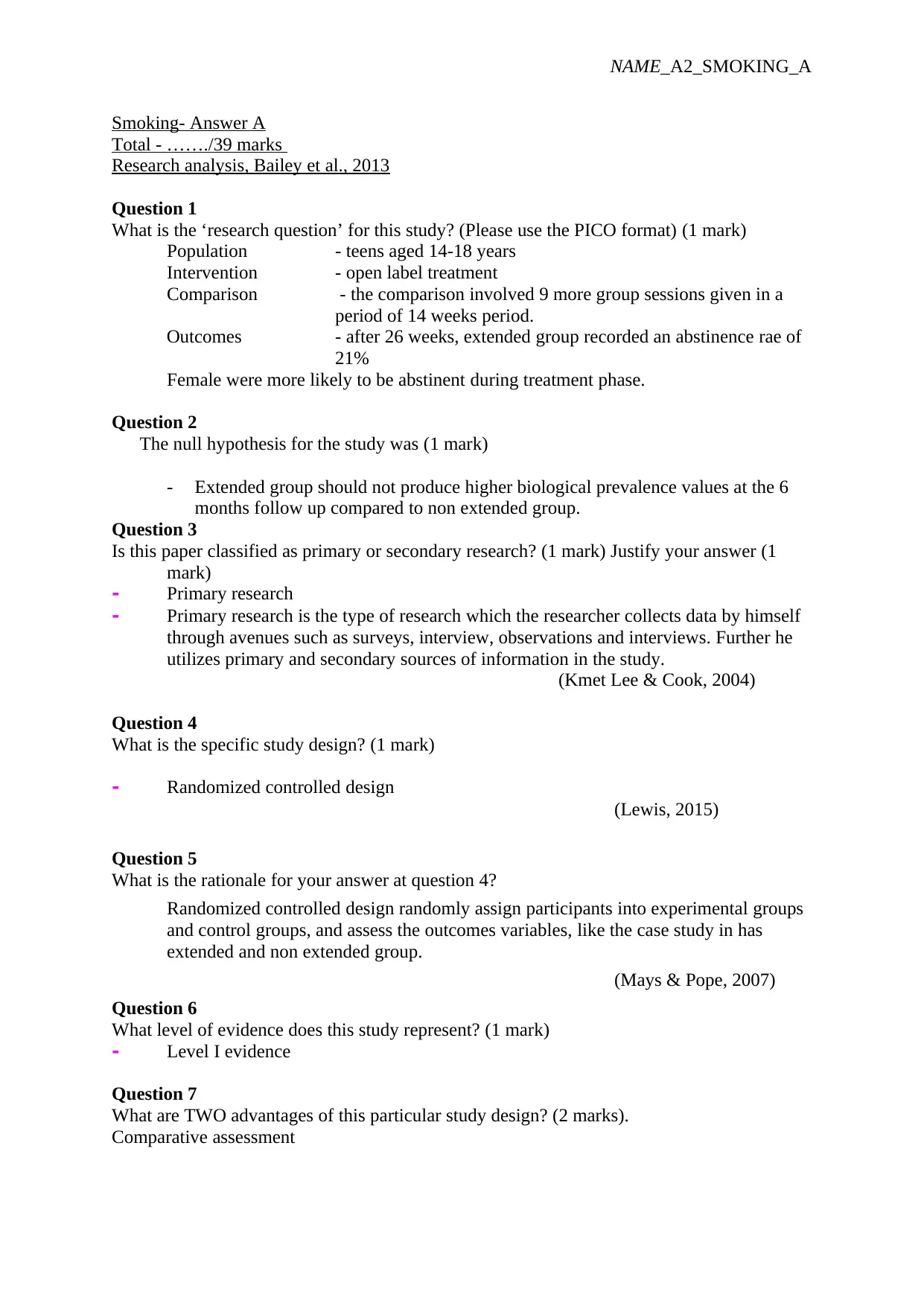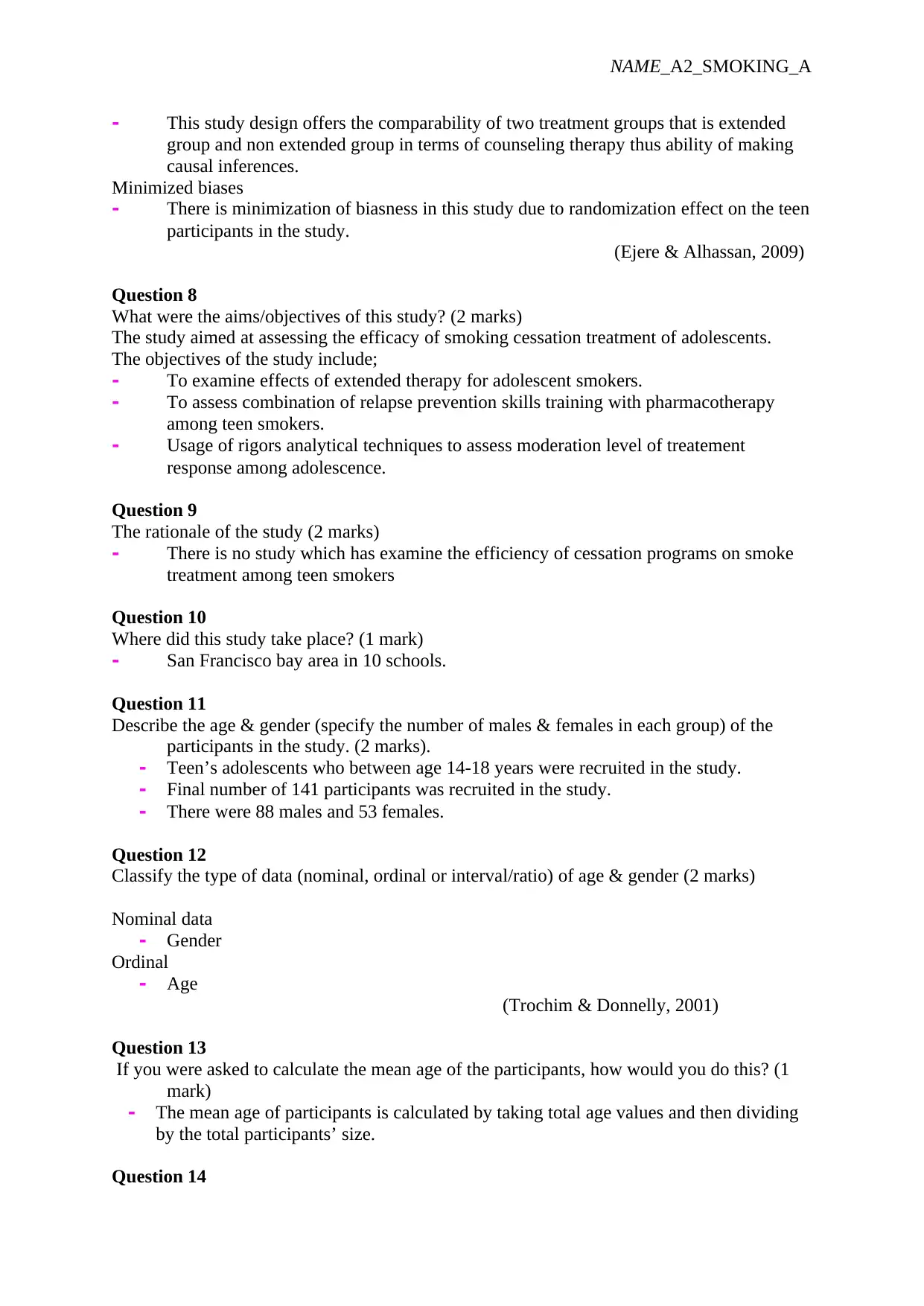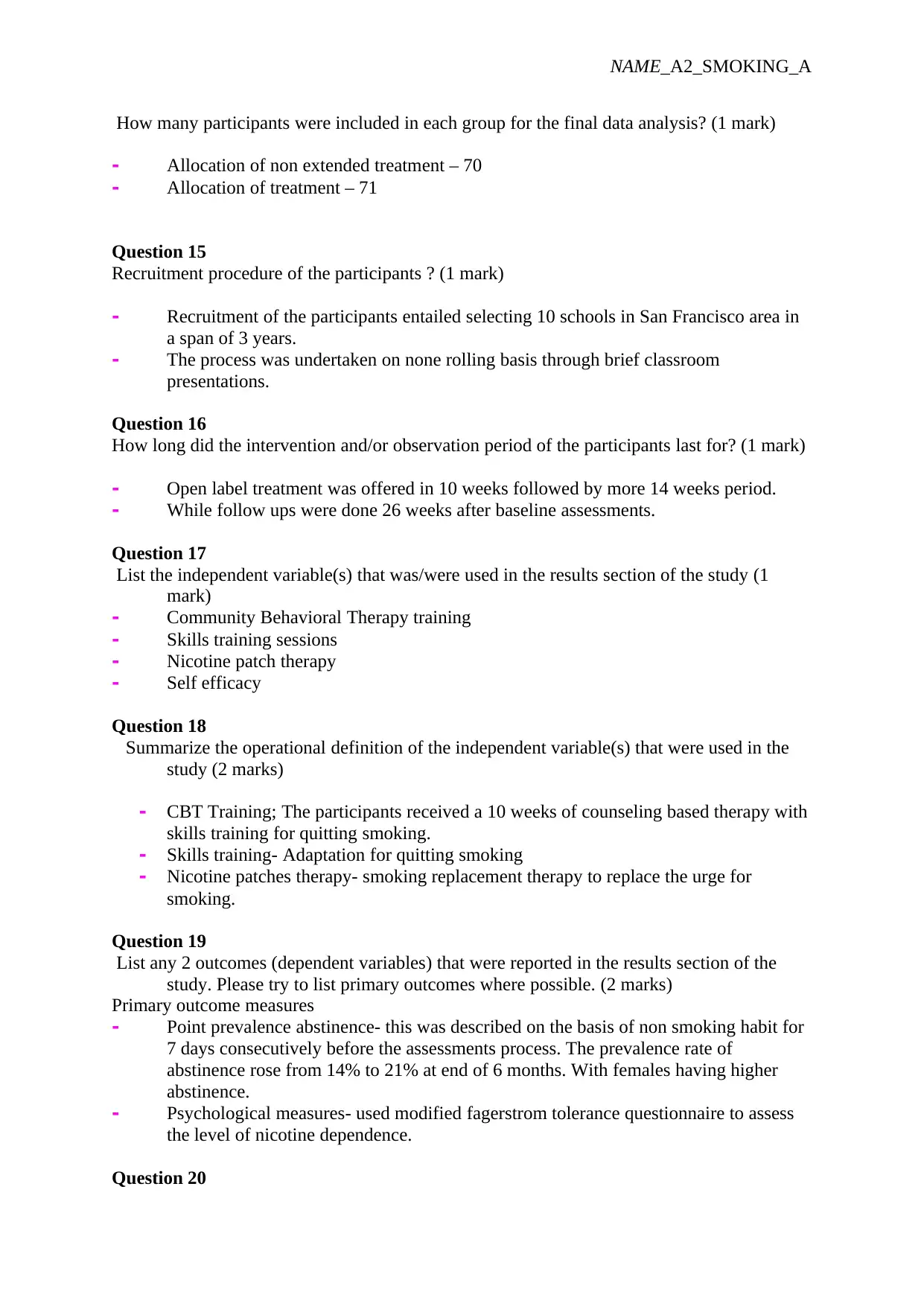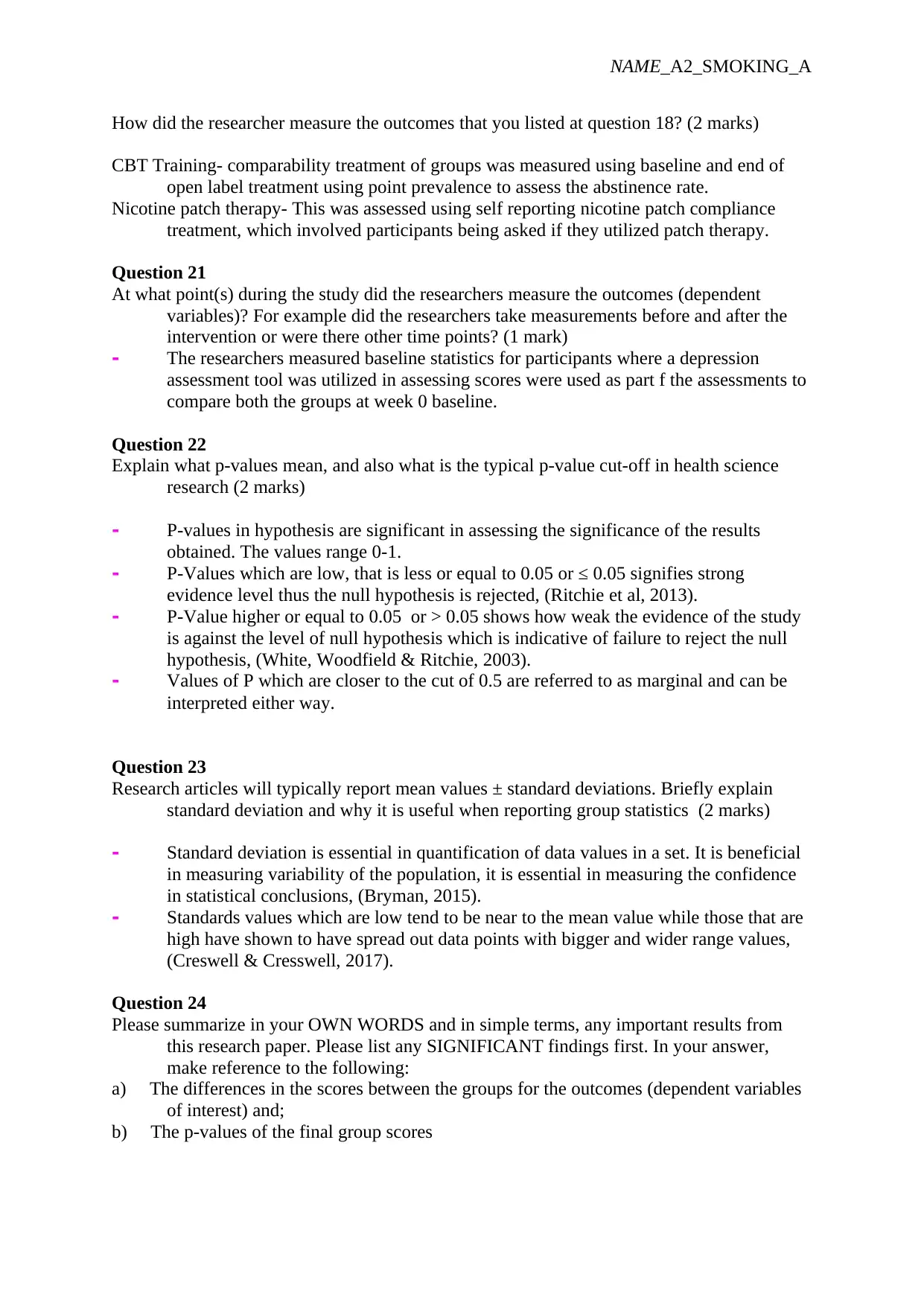Detailed Analysis: Smoking Cessation in Adolescents (Bailey, 2013)
VerifiedAdded on 2023/06/15
|6
|1960
|101
Homework Assignment
AI Summary
This assignment provides a detailed analysis of the research paper 'A Randomized Clinical Trial of the Efficacy of Extended Smoking Cessation Treatment for Adolescent Smokers' by Bailey et al. (2013). The analysis includes identifying the research question in PICO format, stating the null hypothesis, classifying the research type, and determining the study design. It further assesses the level of evidence, advantages of the study design, aims and rationale, study location, participant demographics, and data types. The assignment also summarizes the recruitment procedure, intervention period, independent and dependent variables, outcome measurements, and p-values. The analysis concludes with a summary of important findings, including differences in scores between groups and the significance of p-values, highlighting the efficacy of extended smoking cessation treatment and gender-based differences in abstinence rates.

NAME_A2_SMOKING_A
Smoking- Answer A
Total - ……./39 marks
Research analysis, Bailey et al., 2013
Question 1
What is the ‘research question’ for this study? (Please use the PICO format) (1 mark)
Population - teens aged 14-18 years
Intervention - open label treatment
Comparison - the comparison involved 9 more group sessions given in a
period of 14 weeks period.
Outcomes - after 26 weeks, extended group recorded an abstinence rae of
21%
Female were more likely to be abstinent during treatment phase.
Question 2
The null hypothesis for the study was (1 mark)
- Extended group should not produce higher biological prevalence values at the 6
months follow up compared to non extended group.
Question 3
Is this paper classified as primary or secondary research? (1 mark) Justify your answer (1
mark)
- Primary research
- Primary research is the type of research which the researcher collects data by himself
through avenues such as surveys, interview, observations and interviews. Further he
utilizes primary and secondary sources of information in the study.
(Kmet Lee & Cook, 2004)
Question 4
What is the specific study design? (1 mark)
- Randomized controlled design
(Lewis, 2015)
Question 5
What is the rationale for your answer at question 4?
Randomized controlled design randomly assign participants into experimental groups
and control groups, and assess the outcomes variables, like the case study in has
extended and non extended group.
(Mays & Pope, 2007)
Question 6
What level of evidence does this study represent? (1 mark)
- Level I evidence
Question 7
What are TWO advantages of this particular study design? (2 marks).
Comparative assessment
Smoking- Answer A
Total - ……./39 marks
Research analysis, Bailey et al., 2013
Question 1
What is the ‘research question’ for this study? (Please use the PICO format) (1 mark)
Population - teens aged 14-18 years
Intervention - open label treatment
Comparison - the comparison involved 9 more group sessions given in a
period of 14 weeks period.
Outcomes - after 26 weeks, extended group recorded an abstinence rae of
21%
Female were more likely to be abstinent during treatment phase.
Question 2
The null hypothesis for the study was (1 mark)
- Extended group should not produce higher biological prevalence values at the 6
months follow up compared to non extended group.
Question 3
Is this paper classified as primary or secondary research? (1 mark) Justify your answer (1
mark)
- Primary research
- Primary research is the type of research which the researcher collects data by himself
through avenues such as surveys, interview, observations and interviews. Further he
utilizes primary and secondary sources of information in the study.
(Kmet Lee & Cook, 2004)
Question 4
What is the specific study design? (1 mark)
- Randomized controlled design
(Lewis, 2015)
Question 5
What is the rationale for your answer at question 4?
Randomized controlled design randomly assign participants into experimental groups
and control groups, and assess the outcomes variables, like the case study in has
extended and non extended group.
(Mays & Pope, 2007)
Question 6
What level of evidence does this study represent? (1 mark)
- Level I evidence
Question 7
What are TWO advantages of this particular study design? (2 marks).
Comparative assessment
Paraphrase This Document
Need a fresh take? Get an instant paraphrase of this document with our AI Paraphraser

NAME_A2_SMOKING_A
- This study design offers the comparability of two treatment groups that is extended
group and non extended group in terms of counseling therapy thus ability of making
causal inferences.
Minimized biases
- There is minimization of biasness in this study due to randomization effect on the teen
participants in the study.
(Ejere & Alhassan, 2009)
Question 8
What were the aims/objectives of this study? (2 marks)
The study aimed at assessing the efficacy of smoking cessation treatment of adolescents.
The objectives of the study include;
- To examine effects of extended therapy for adolescent smokers.
- To assess combination of relapse prevention skills training with pharmacotherapy
among teen smokers.
- Usage of rigors analytical techniques to assess moderation level of treatement
response among adolescence.
Question 9
The rationale of the study (2 marks)
- There is no study which has examine the efficiency of cessation programs on smoke
treatment among teen smokers
Question 10
Where did this study take place? (1 mark)
- San Francisco bay area in 10 schools.
Question 11
Describe the age & gender (specify the number of males & females in each group) of the
participants in the study. (2 marks).
- Teen’s adolescents who between age 14-18 years were recruited in the study.
- Final number of 141 participants was recruited in the study.
- There were 88 males and 53 females.
Question 12
Classify the type of data (nominal, ordinal or interval/ratio) of age & gender (2 marks)
Nominal data
- Gender
Ordinal
- Age
(Trochim & Donnelly, 2001)
Question 13
If you were asked to calculate the mean age of the participants, how would you do this? (1
mark)
- The mean age of participants is calculated by taking total age values and then dividing
by the total participants’ size.
Question 14
- This study design offers the comparability of two treatment groups that is extended
group and non extended group in terms of counseling therapy thus ability of making
causal inferences.
Minimized biases
- There is minimization of biasness in this study due to randomization effect on the teen
participants in the study.
(Ejere & Alhassan, 2009)
Question 8
What were the aims/objectives of this study? (2 marks)
The study aimed at assessing the efficacy of smoking cessation treatment of adolescents.
The objectives of the study include;
- To examine effects of extended therapy for adolescent smokers.
- To assess combination of relapse prevention skills training with pharmacotherapy
among teen smokers.
- Usage of rigors analytical techniques to assess moderation level of treatement
response among adolescence.
Question 9
The rationale of the study (2 marks)
- There is no study which has examine the efficiency of cessation programs on smoke
treatment among teen smokers
Question 10
Where did this study take place? (1 mark)
- San Francisco bay area in 10 schools.
Question 11
Describe the age & gender (specify the number of males & females in each group) of the
participants in the study. (2 marks).
- Teen’s adolescents who between age 14-18 years were recruited in the study.
- Final number of 141 participants was recruited in the study.
- There were 88 males and 53 females.
Question 12
Classify the type of data (nominal, ordinal or interval/ratio) of age & gender (2 marks)
Nominal data
- Gender
Ordinal
- Age
(Trochim & Donnelly, 2001)
Question 13
If you were asked to calculate the mean age of the participants, how would you do this? (1
mark)
- The mean age of participants is calculated by taking total age values and then dividing
by the total participants’ size.
Question 14

NAME_A2_SMOKING_A
How many participants were included in each group for the final data analysis? (1 mark)
- Allocation of non extended treatment – 70
- Allocation of treatment – 71
Question 15
Recruitment procedure of the participants ? (1 mark)
- Recruitment of the participants entailed selecting 10 schools in San Francisco area in
a span of 3 years.
- The process was undertaken on none rolling basis through brief classroom
presentations.
Question 16
How long did the intervention and/or observation period of the participants last for? (1 mark)
- Open label treatment was offered in 10 weeks followed by more 14 weeks period.
- While follow ups were done 26 weeks after baseline assessments.
Question 17
List the independent variable(s) that was/were used in the results section of the study (1
mark)
- Community Behavioral Therapy training
- Skills training sessions
- Nicotine patch therapy
- Self efficacy
Question 18
Summarize the operational definition of the independent variable(s) that were used in the
study (2 marks)
- CBT Training; The participants received a 10 weeks of counseling based therapy with
skills training for quitting smoking.
- Skills training- Adaptation for quitting smoking
- Nicotine patches therapy- smoking replacement therapy to replace the urge for
smoking.
Question 19
List any 2 outcomes (dependent variables) that were reported in the results section of the
study. Please try to list primary outcomes where possible. (2 marks)
Primary outcome measures
- Point prevalence abstinence- this was described on the basis of non smoking habit for
7 days consecutively before the assessments process. The prevalence rate of
abstinence rose from 14% to 21% at end of 6 months. With females having higher
abstinence.
- Psychological measures- used modified fagerstrom tolerance questionnaire to assess
the level of nicotine dependence.
Question 20
How many participants were included in each group for the final data analysis? (1 mark)
- Allocation of non extended treatment – 70
- Allocation of treatment – 71
Question 15
Recruitment procedure of the participants ? (1 mark)
- Recruitment of the participants entailed selecting 10 schools in San Francisco area in
a span of 3 years.
- The process was undertaken on none rolling basis through brief classroom
presentations.
Question 16
How long did the intervention and/or observation period of the participants last for? (1 mark)
- Open label treatment was offered in 10 weeks followed by more 14 weeks period.
- While follow ups were done 26 weeks after baseline assessments.
Question 17
List the independent variable(s) that was/were used in the results section of the study (1
mark)
- Community Behavioral Therapy training
- Skills training sessions
- Nicotine patch therapy
- Self efficacy
Question 18
Summarize the operational definition of the independent variable(s) that were used in the
study (2 marks)
- CBT Training; The participants received a 10 weeks of counseling based therapy with
skills training for quitting smoking.
- Skills training- Adaptation for quitting smoking
- Nicotine patches therapy- smoking replacement therapy to replace the urge for
smoking.
Question 19
List any 2 outcomes (dependent variables) that were reported in the results section of the
study. Please try to list primary outcomes where possible. (2 marks)
Primary outcome measures
- Point prevalence abstinence- this was described on the basis of non smoking habit for
7 days consecutively before the assessments process. The prevalence rate of
abstinence rose from 14% to 21% at end of 6 months. With females having higher
abstinence.
- Psychological measures- used modified fagerstrom tolerance questionnaire to assess
the level of nicotine dependence.
Question 20
⊘ This is a preview!⊘
Do you want full access?
Subscribe today to unlock all pages.

Trusted by 1+ million students worldwide

NAME_A2_SMOKING_A
How did the researcher measure the outcomes that you listed at question 18? (2 marks)
CBT Training- comparability treatment of groups was measured using baseline and end of
open label treatment using point prevalence to assess the abstinence rate.
Nicotine patch therapy- This was assessed using self reporting nicotine patch compliance
treatment, which involved participants being asked if they utilized patch therapy.
Question 21
At what point(s) during the study did the researchers measure the outcomes (dependent
variables)? For example did the researchers take measurements before and after the
intervention or were there other time points? (1 mark)
- The researchers measured baseline statistics for participants where a depression
assessment tool was utilized in assessing scores were used as part f the assessments to
compare both the groups at week 0 baseline.
Question 22
Explain what p-values mean, and also what is the typical p-value cut-off in health science
research (2 marks)
- P-values in hypothesis are significant in assessing the significance of the results
obtained. The values range 0-1.
- P-Values which are low, that is less or equal to 0.05 or ≤ 0.05 signifies strong
evidence level thus the null hypothesis is rejected, (Ritchie et al, 2013).
- P-Value higher or equal to 0.05 or > 0.05 shows how weak the evidence of the study
is against the level of null hypothesis which is indicative of failure to reject the null
hypothesis, (White, Woodfield & Ritchie, 2003).
- Values of P which are closer to the cut of 0.5 are referred to as marginal and can be
interpreted either way.
Question 23
Research articles will typically report mean values ± standard deviations. Briefly explain
standard deviation and why it is useful when reporting group statistics (2 marks)
- Standard deviation is essential in quantification of data values in a set. It is beneficial
in measuring variability of the population, it is essential in measuring the confidence
in statistical conclusions, (Bryman, 2015).
- Standards values which are low tend to be near to the mean value while those that are
high have shown to have spread out data points with bigger and wider range values,
(Creswell & Cresswell, 2017).
Question 24
Please summarize in your OWN WORDS and in simple terms, any important results from
this research paper. Please list any SIGNIFICANT findings first. In your answer,
make reference to the following:
a) The differences in the scores between the groups for the outcomes (dependent variables
of interest) and;
b) The p-values of the final group scores
How did the researcher measure the outcomes that you listed at question 18? (2 marks)
CBT Training- comparability treatment of groups was measured using baseline and end of
open label treatment using point prevalence to assess the abstinence rate.
Nicotine patch therapy- This was assessed using self reporting nicotine patch compliance
treatment, which involved participants being asked if they utilized patch therapy.
Question 21
At what point(s) during the study did the researchers measure the outcomes (dependent
variables)? For example did the researchers take measurements before and after the
intervention or were there other time points? (1 mark)
- The researchers measured baseline statistics for participants where a depression
assessment tool was utilized in assessing scores were used as part f the assessments to
compare both the groups at week 0 baseline.
Question 22
Explain what p-values mean, and also what is the typical p-value cut-off in health science
research (2 marks)
- P-values in hypothesis are significant in assessing the significance of the results
obtained. The values range 0-1.
- P-Values which are low, that is less or equal to 0.05 or ≤ 0.05 signifies strong
evidence level thus the null hypothesis is rejected, (Ritchie et al, 2013).
- P-Value higher or equal to 0.05 or > 0.05 shows how weak the evidence of the study
is against the level of null hypothesis which is indicative of failure to reject the null
hypothesis, (White, Woodfield & Ritchie, 2003).
- Values of P which are closer to the cut of 0.5 are referred to as marginal and can be
interpreted either way.
Question 23
Research articles will typically report mean values ± standard deviations. Briefly explain
standard deviation and why it is useful when reporting group statistics (2 marks)
- Standard deviation is essential in quantification of data values in a set. It is beneficial
in measuring variability of the population, it is essential in measuring the confidence
in statistical conclusions, (Bryman, 2015).
- Standards values which are low tend to be near to the mean value while those that are
high have shown to have spread out data points with bigger and wider range values,
(Creswell & Cresswell, 2017).
Question 24
Please summarize in your OWN WORDS and in simple terms, any important results from
this research paper. Please list any SIGNIFICANT findings first. In your answer,
make reference to the following:
a) The differences in the scores between the groups for the outcomes (dependent variables
of interest) and;
b) The p-values of the final group scores
Paraphrase This Document
Need a fresh take? Get an instant paraphrase of this document with our AI Paraphraser

NAME_A2_SMOKING_A
- The results indicate that there marked averages on cigarettes smoked in week.
Females showed higher baseline score compared to males at (F(1,139) = 10, p
= .0014).
- At baseline, there was difference in the average treatment in the group with depression
scale showing higher mean than non extended treatment group.
- There was no difference observed in open label point prevalence with regard to
abstinence treatment of groups.
- There was an abstinence rate of 14% for the extended group while the other group had
7%.
- Usage of patch therapy was observed at the rate of 4 out of 7 days.
- The study concluded that there was efficacy of smoke therapy session in lowering the
rate of smoking cessation when comparison was made to the other group that did not
receive treatment. Further females showed high rates of abstinence compared to males
after 6 months duration contrary to other studies.
References
Bailey, S. R., Hagen, S. A., Jeffery, C. J., Harrison, C. T., Ammerman, S., Bryson, S. W., ...
& Killen, J. D. (2013). A randomized clinical trial of the efficacy of extended smoking
cessation treatment for adolescent smokers. nicotine & tobacco research, 15(10), 1655-
1662.
Bryman, A. (2015). Social research methods. Oxford university press.
Creswell, J. W., & Creswell, J. D. (2017). Research design: Qualitative, quantitative, and
mixed methods approaches. Sage publications.
Ejere, H., & Alhassan, M. B. (2009). Frequency of Reporting and the Quality of Randomized
Controlled Trials Published in the Nigerian Journal of Ophthalmology. Nigerian
Journal of Ophthalmology, 17(2).
Kmet, L. M., Lee, R. C., & Cook, L. S. (2004). Standard quality assessment criteria for
evaluating primary research papers from a variety of fields.
Lewis, S. (2015). Qualitative inquiry and research design: Choosing among five approaches.
Health promotion practice, 16(4), 473-475.
Mays, N., & Pope, C. (2007). Quality in qualitative health research. Qualitative Research in
Health Care, Third Edition, 82-101.
Ritchie, J., Lewis, J., Nicholls, C. M., & Ormston, R. (Eds.). (2013). Qualitative research
practice: A guide for social science students and researchers. Sage.
Trochim, W. M., & Donnelly, J. P. (2001). Research methods knowledge base.
White, C., Woodfield, K., & Ritchie, J. (2003). Reporting and presenting qualitative data.
Qualitative research practice: A guide for social science students and researchers,
287-320.
- The results indicate that there marked averages on cigarettes smoked in week.
Females showed higher baseline score compared to males at (F(1,139) = 10, p
= .0014).
- At baseline, there was difference in the average treatment in the group with depression
scale showing higher mean than non extended treatment group.
- There was no difference observed in open label point prevalence with regard to
abstinence treatment of groups.
- There was an abstinence rate of 14% for the extended group while the other group had
7%.
- Usage of patch therapy was observed at the rate of 4 out of 7 days.
- The study concluded that there was efficacy of smoke therapy session in lowering the
rate of smoking cessation when comparison was made to the other group that did not
receive treatment. Further females showed high rates of abstinence compared to males
after 6 months duration contrary to other studies.
References
Bailey, S. R., Hagen, S. A., Jeffery, C. J., Harrison, C. T., Ammerman, S., Bryson, S. W., ...
& Killen, J. D. (2013). A randomized clinical trial of the efficacy of extended smoking
cessation treatment for adolescent smokers. nicotine & tobacco research, 15(10), 1655-
1662.
Bryman, A. (2015). Social research methods. Oxford university press.
Creswell, J. W., & Creswell, J. D. (2017). Research design: Qualitative, quantitative, and
mixed methods approaches. Sage publications.
Ejere, H., & Alhassan, M. B. (2009). Frequency of Reporting and the Quality of Randomized
Controlled Trials Published in the Nigerian Journal of Ophthalmology. Nigerian
Journal of Ophthalmology, 17(2).
Kmet, L. M., Lee, R. C., & Cook, L. S. (2004). Standard quality assessment criteria for
evaluating primary research papers from a variety of fields.
Lewis, S. (2015). Qualitative inquiry and research design: Choosing among five approaches.
Health promotion practice, 16(4), 473-475.
Mays, N., & Pope, C. (2007). Quality in qualitative health research. Qualitative Research in
Health Care, Third Edition, 82-101.
Ritchie, J., Lewis, J., Nicholls, C. M., & Ormston, R. (Eds.). (2013). Qualitative research
practice: A guide for social science students and researchers. Sage.
Trochim, W. M., & Donnelly, J. P. (2001). Research methods knowledge base.
White, C., Woodfield, K., & Ritchie, J. (2003). Reporting and presenting qualitative data.
Qualitative research practice: A guide for social science students and researchers,
287-320.

NAME_A2_SMOKING_A
⊘ This is a preview!⊘
Do you want full access?
Subscribe today to unlock all pages.

Trusted by 1+ million students worldwide
1 out of 6
Related Documents
Your All-in-One AI-Powered Toolkit for Academic Success.
+13062052269
info@desklib.com
Available 24*7 on WhatsApp / Email
![[object Object]](/_next/static/media/star-bottom.7253800d.svg)
Unlock your academic potential
Copyright © 2020–2025 A2Z Services. All Rights Reserved. Developed and managed by ZUCOL.




